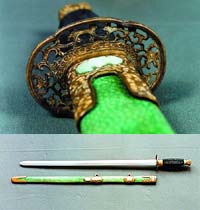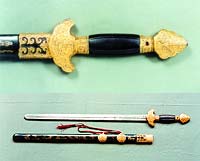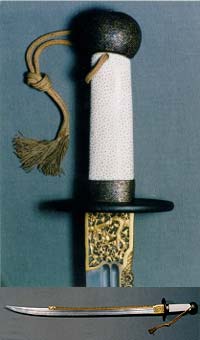The Art of the Chinese Sword
By Philip Tom
The medieval Chinese dynasties saw great advances in metallurgy. Some,
like the ability to produce cast iron, were far ahead of such technology
in the Europe. Others, like the mastery of efficient, large-scale steel
production, enabled the Tang and Song dynasties to become major military
powers in east Asia.

SWORD (jian)
probably 18th century
Blade length
28 1/2" in.
|
The finely-forged blade of dual-row huawen (flowery-figured)
damascus steel, the lamellae of the twists running obliquely towards
the point on either side of the median ridge. The fittings of
chased and pierced brass, fire-gilt, and set with carved jade
plaques. The scabbard surfaced with dyed shagreen. An example
which is important not only for its workmanship and embellishment,
but also for the use of a hilt styled after a peidao, or saber.
Saber-hilted jian are depicted on Ming Dynasty imperial tomb guardian
figures, and a few sumptuous examples of such swords, probably
made at the imperial workshops in the Forbidden City, are extant
from the first half of the Qing.
|
Most collectors of Asian arms are aware that the techniques of forging
and tempering developed in China are the basis from which developed the
reknowned Japanese swords. These skills arrived in Japan as early as the
Sui and Tang dynasty China (AD 589 onward).
The connoisseurship of Japanese sword has thrived over the centuries
and has gained an international following in our time. Today Japanese
blades are rightly treasured as works of art on their own. Unfortunately,
the appreciation of swords produced by the 'parent' smiths of China languished
even in its native land. This is despite the fact that very fine blades
were made in China, and that hand-to-hand combat with edged weapons often
proved crucial in winning battles up through the end of the imperial period.
Sadly, even enthusiastic Chinese practitioners of martial arts tend to
be ignorant of the history, manufacture, and aesthetic traditions of the
weapons they train with daily. Non-Chinese are in no better state. There
is difficulty in reconciling the beautiful specimens on display in venues
such as the Forbidden City, Muse de l'Arme in Paris, or the Moscow Kremlin
with the shoddy "Boxer Rebellion trophies" or touristic bric-a-brac often
seen in antique shops or at gun shows.
A major reason for this situation lies in the scarcity of literature
on the subject readily accessible to today's students. This paucity of
reference material has not always been the case in China. A survey of
technical and artistic treatises reveals a considerable number of works
dealing with steel bladed swords, published as early as the 4th cent.
AD. (There is an equally impressive body of material dealing with the
earlier bronze weapons). However, the publication of such works dwindled
sharply after the fall of the Ming Dynasty in 1644.
It is not known for certain why there is a relative scarcity of reference
material written on swords during the Qing, the last imperial dynasty,
which fell in 1911. A common explanation is that the ruling Manchus, who
formed a small percentage of the empire's population, suppressed all writing
on military subjects out of fear of insurgency by the Han Chinese majority.

SWORD, (jian)
of composite origin, the mounts possibly late Ming though more
likely early-to-mid Qing, blade possibly earlier
Blade length 26" in.
|
The bifullered blade of stout proportions, of
sanmei (three-fold) structure, with a high-carbon layer between
two softer and more resilient lamellar cheeks (heavily damaged
by corrosion, and loss of temper due to fire) mounted in gilt
bronze fittings with decoration in relief, with a grip of huanghuali
wood and a wooden scabbard with dragon and cloud motifs in black
lacquer (the chape missing).
The pairing of a damaged and no longer functional
blade to such sumptuous mounts points to the desire to maintain
an salvaged heirloom sword as a piece of ceremonial regalia. The
Qing aristocracy continued the Ming custom of having large and
ornate jian, sheathed and encased in brocade, borne by attendents
in processions
|
At the beginning of the Qing dynasty, certain works such
as Ming-era military encyclopedias were censored and restricted. However,
a survey of Qing technical literature does show that a fair number of
new titles were written and published throughout the dynasty. After all,
the Qing still had need for the information for the benefit of its armed
forces (which were predominately composed of Han Chinese troops). Research
also has shown that Qing rulers could be quite pragmatic about the bearing
of arms by the general populace: for instance, the Kangxi emperor was
known to have vetoed a request by an official to disarm the people of
Shandong Province.
What is interesting, however, about the military books published during
the Qing is that they invarably deal with firearms, artillery, and explosive
weapons. (These texts date primarily from the mid-nineteenth century when
the empire was racked by rebellion). Even the classic late Ming encyclopedia,
Wubeizhi, gives bladed weapons relatively scant attention. Why would this
be so, despite the fact that edged weapons were a mainstay in the empire's
arsenals? It could be that sword technology was by then considered "old
hat", so well known by those whose job it was to master it that it hardly
warranted repetition in books devoted to new technology.

CEREMONIAL SABER OF THE IMPERIAL COURT
(Huangchao Baolidao) Qianlong reign,
ca. 1760-95
(mounts later)
Blade length 30 5/8 in.
|
The pattern-welded blade of qiangang (inserted
edge-layer) construction, the dorsal side sculpted to represent
an extended dragon, with serrated spine and a modelled, openwork
head at the base of the backedge, and with a chiselled panel at
the forte containing the Imperial five-clawed dragon chasing the
sacred jewel amid foliage. The carved detail accentuated with
encrusted gold leaf, except for the "scales" of the dragon's back,
which are composed of hundreds of inlaid gold plugs. In replaced
iron mounts of a later period and lesser workmanship, embellished
with swastika fretwork in gold encrustation.
The Qianlong emperor (r. 1736-95) was among the
last of China's imperial rulers to take an active interest in
warfare and the hunt. A connoisseur of swords, he commissioned
the Imperial workshops at Beijing to make dozens of sumptuous
and unique pieces. An illustrated inventory of Court ceremonial
regalia and official uniform regulations, the Huangchao liqi tushi
of 1759, lists a pallasch or zhibeidao with identical dragon decor
along its dorsal ridge. This saber, with its curved blade, does
not appear in the inventory, so we can surmise that it was made
after 1759. There are also a number of short pallasches with this
dragon motif which are still preserved in various museums in the
People's Republis of China. Only one other example of this form
of saber blade is known. It appears to retain its original mountings,
which are of elaborately pierced iron, studded with gemstones,
and gilt.
The five-clawed dragon was exclusively reserved
for the Emperor and his Immediate family. The swastika is one
of the auspicious symbols of Buddhism.
|
It is also interesting to note that although Ming aesthetes had quite
a bit to say about swords as an art form. There is however, little evidence
to show that this appreciation remained strong during the Qing. A possible
explanation could be that the tastes of China's cultural elite tended
to narrow as the centuries passed, becoming ever more preoccupied with
arcane details of a few, beloved major art forms such as painting, porcelain,
and jade. A parallel can be drawn with the decline of the furniture tradition
during the later Qing. Finally, we must also take note of the influence
of Confucian values, which tended to denigrate things military in favor
of literary interests. During the transition to Manchu rule it may also
have been a pragmatic choice for scholars not to show too great an interest
in arms.
What makes the study of the Chinese sword tradition a real challenge
is that those who are studying it in our time must be explorers and pioneers,
not passive consumers. There is much to be done in uncovering and translating
the old texts that have survived. Even more exciting is the fresh look
that we can get at the achievements of the past, by studying blades that
have been carefully polished and restored.
Our research to date shows that the swordsmiths of China, over the last
20 centuries, have crafted blades combining the following attributes:
1. A hard and durable edge.
2. A resilient body which absorbs shock without breaking.
In a sword, these goals can be mutually exclusive. Hard steel tends to
be brittle; a resilient, springy steel is softer and will not hold an
edge as well. Chinese smiths got around this problem by combining hard
and soft steels in varying ways. There are three basic methods. One is
called baogang, or "wrapped" steel. The hard, high-carbon steel that forms
the cutting edge looks, in cross-section, like a "V" which encloses a
softer core of mild steel. The core metal is often folded upon itself
for more strength, or layered with wrought iron for the same effect. A
baogang blade must be made with a fairly thick jacket of hard steel, or
else it loses its strength with repeated sharpening and grinding.
A more common form of blade forging is qiangang, or "inserted"steel.
The high-carbon edge forms a core with is sandwiched between "cheeks"
of mild steel. The cheeks are often made of alternating layers of iron
and steel, which produce a pattern on the surface when the blade is polished.
A skilled smith can manipulate the layers to produce patterns of great
beauty, in addition to providing structural strength to the sword.
The last major type of forging is known in the West as "twistcore". This
type is formed of parallel bars of twisted layers of hard and soft steel,
all welded into a single unit under heat and hammer. When ground and polished,
the surface resembles rows of feathery, star-shaped, or swirling elements.
The other area in which Chinese smiths showed considerable ingenuity
was hardening the blade by heating and quenching in liquid. This technique
is almost universal, wherever blades are manufactured. China was one of
the few places in which techniques were devised to differentially heat-treat
the edge, as opposed to the entire blade. This practice increased the
strength and cutting ability of the blade. It was developed to the highest
level by the Japanese, who originally utilized the skills of immigrant
smiths from China and Korea.
|
|
Chinese suishu peidao ( Imperial
Attendants Saber ) of qiangang (inserted steel) with the vein
(inserted edge) distinguisted from the gu (body) of the blade
by way of a serrrated delineation.
|
|
|
A chinese broad peidao with joui row twist core
configuration (huaweu-gaug) with marked differentual hardening at
the edge.
|
|
|
A Chinese jian with dual rows of huawen (flowery
figured) Damascus steel with lamdelae of twists running obliquely
towards the point on either side of the median ridge.
|
The beauty of the Chinese swordsmith's craft is an art form just beginning
to be rediscovered in China and elsewhere. We live in a time when new
discoveries are made day to day. As we begin to see the beautiful patterns
that raise from the marriage of form and function to create a sword blade
of superior quality steel, we are only begining our study of the Chinese
armor's craft. There many other areas of study waiting to be explored,
from decorative motif and their symbolism to the blade aesthetics that
are subtly married to function.
© Seven
Stars Trading Co. 1998
Posted with permission of Philip Tom, and Scott Rodell on whose wedbsite
the article was originally presented.
About the author:
Philip Tom has more than 25 years' experience in research and restoration
of arms and armor, with an intimate knowledge of their historical development,
manufacturing technique and aesthetic traditions. Mr. Tom is the author
of "Some Notable Sabers of the Quing Dynasty in the Metropolitan
Museum of Art", to be published in 2001 in Metropolitan Museum
Journal, Vol. 36. He has addressed the Society of Ethnographic &
Historical Edged Weapons Collectors of Israel, lecturing on Ming and
Quing armes-blanches, in Tel Aviv in 2000. He has also been an Advisor
on Chinese armament to the National Maritime Museum in Haifa, Israel,
for a special exhibition on piracy. Mr. Tom was an historical consultant
for a documentary telecast "Oriental Firearms" (part of the
Tales of the Gun series) distributed by the History Channel in 2000,
and was the curator and conservator for "Sword & Brush: Art
from China's Martial Tradition", an exhibit at the Great River
Taoist Center in Washington DC in the fall of 1999. Mr. Tom has a Master
of Arts degree in History from the University of Hawaii, Manoa Campus.
|